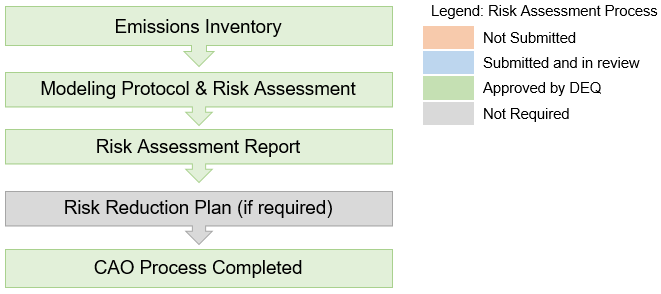Air Toxics Health Risk Assessment Status
Cleaner Air Oregon is a health-based permitting program that regulates emissions of toxic air contaminants from facilities based on risk to nearby communities. CAO requires facilities to report toxic air contaminant emissions, assess potential health risks to people nearby and reduce toxic air contaminant risk if it exceeds legal limits.
As part of the Cleaner Air Oregon process, each facility has a dedicated web page to provide communities access to facility information and updates on where it is in the risk assessment process.
- Each step of the CAO risk assessment process has a section that includes DEQ's communications and deliverables with the facility.
- The color-coded graphic below shows where a facility is in the Cleaner Air Oregon process.
- For additional information and history of the program, visit the Cleaner Air Oregon web page

The Emissions Inventory provides information on all the Toxic Air Contaminant emissions from a facility, and includes information on a facility’s operations and activities, as well as fuel and material usage rates. This is often the longest step in the CAO risk assessment process as DEQ needs to verify that all activities have been accounted for, and that the most representative emissions data available are used. In some cases, DEQ will require a facility to perform source testing at this stage if insufficient data is available to estimate emissions.
For an introduction to emissions inventories and why they matter, please see EPA's Fact Sheet. A facility-specific emissions inventory timeline and associated documents are linked below.
Nov. 30, 2021: DEQ approves Emissions Inventory
The Modeling Protocol provides information on how the facility plans to accurately model the concentrations of Toxic Air Contaminants (TACs) that community members may be exposed to based on the TAC emissions data from the approved Emissions Inventory. A Risk Assessment Work Plan is required for more complex Risk Assessments (Level 3 or Level 4) and provides more detailed information about locations where people live or normally congregate around the facility and how risk to these community members will be evaluated.
Nov. 9, 2021: NEXT submits Exposure Location Change Request
Nov. 30, 2021: NEXT submits combined Modeling Protocol and Risk Assessment Work Plan
The Risk Assessment provides the summary of findings on potential risks to the surrounding community from emissions of Toxic Air Contaminants from this facility. The assessment indicates the exposure location(s) in the community with the highest potential Cancer and Noncancer health risk, and DEQ uses this information to regulate TAC emissions from the facility. In some cases, the risk may be very low, and no further action may be required, or the risk may exceed health-based standards where DEQ can require risk reductions. In most cases, permit conditions will be developed and included in a facility's air quality permit to regulate TAC emissions based on the results of the risk assessment.
Oct. 22, 2021: NEXT submits Risk Assessment Report
Dec. 14, 2021: DEQ approves Risk Assessment
About the Facility
NEXT Renewable Fuels, LLC. is proposing to construct a renewable diesel, renewable naphtha and renewable jet fuel manufacturing facility at the Port of Columbia County's Port Westward Industrial Park in Clatskanie. For additional information on this facility, please visit DEQ's NEXT Renewable Fuels project page.